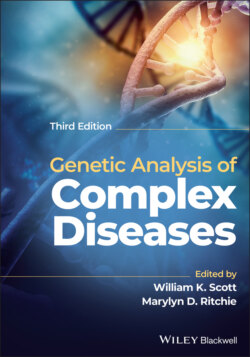Читать книгу Genetic Analysis of Complex Disease - Группа авторов - Страница 42
Autosomal Dominant
ОглавлениеIn a dominant condition, a genetic mutation in a single copy of a gene is sufficient to cause a disease or trait. Dominant conditions may be inherited through an affected parent or alternatively may have occurred as the result of a de novo genetic mutation. Some de novo dominant mutations have been shown to be associated with increased paternal age (Friedman 1981). Some dominant conditions may exhibit reduced penetrance, in which a person carries a causative gene but does not exhibit any manifestations of the condition. On the other hand, variable expressivity refers to the range of features that may be observed in individuals with the same condition. Codominance, in which a trait is expressed from both alleles, has also been observed in certain traits, for example, in AB blood type.
Table 2.3 Hallmarks of Mendelian inheritance patterns of different types.
| Inheritance pattern | Examples | Transmission features | Recurrence risk | Prevalence in population | Other critical features |
|---|---|---|---|---|---|
| Autosomal dominant | Marfan syndrome; neurofibromatosis; myotonic dystrophy | Transmitted from affected parent to affected offspring (vertical transmission) male‐to‐male possible transmission; de novo mutations may occur | For each offspring of affected parent, risk to child to inherit disease gene is 50% | p2 + 2pq | Reduced penetrance may be observed |
| Autosomal recessive | Sickle cell anemia; cystic fibrosis | Carrier parents generally unaffected | For carrier parents, risk for each subsequent child is 25% | q2 | Consanguinity considered |
| X‐linked | Duchenne muscular dystrophy; fragile X syndrome; hemophilia | No male‐to‐male transmission; de novo mutations may rarely occur | 50% of offspring of carrier female have trait (if male, affected, if female carrier); all female offspring of affected male are carriers | Females: q2; males: q | Females may show sub‐clinical, atypical, or fully penetrant features of the condition. Non‐random X inactivation may contribute to more severe female phenotype. |
| Y linked | Genes SRY and TDF, important in sex determination, are on the Y chromosome; no known diseases are located on Y | Exclusively male‐to‐male transmission | All sons of affected males are affected; no daughters of affected males are affected | Females: 0; males: q | Male‐determining genes are located just proximal to pseudoautosomal region on Y chromosome; faulty recombination in pseudoautosomal region can lead to errors in sex determination |
| Autosomal codominant | MN blood group; microsatellite repeat markers | Each allele confers measurable component to phenotype | Varies according to mating type | Genotypes expected to occur in Hardy–Weinberg proportions of p2, 2pq, and q2 | |
| Mitochondrial | Leber’s optic atrophy; KSS (Kearns–Sayre syndrome); MELAS (mitochondrial myopathy, encephalopathy, lactic acidosis and stroke‐like episodes); | Exclusively maternal transmission through maternal mitochondria | All offspring of affected females are at risk to inherit mutation (may be affected or carrier). Proportion of affected offspring is variable based on maternal heteroplasmy. Offspring of affected male not at risk to inherit mutation. | Heteroplasmy may determine phenotypic severity. Majority of mitochondrial diseases are due to mutations in the nuclear genome rather than the mitochondrial genome and follow autosomal recessive inheritance pattern. |
Figure 2.10 Pedigrees consistent with (a) autosomal dominant inheritance, (b) autosomal recessive inheritance, (c) X‐linked recessive inheritance, (d) X‐linked dominant inheritance, and (e) mitochondrial inheritance. Here and elsewhere squares indicate males, circles indicate females, open symbols indicate unaffected individuals, and solid symbols indicate affected individuals.
